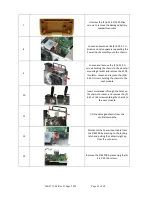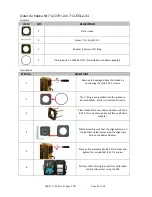
906-0731-04 Rev. B Sept. 2012
Page 12 of 68
CAUTION!
If filters have been exposed to biological matter dispose of them following Universal Precaution
procedures for your facility.
NOTE:
Do not attempt to clean this filter and do not operate internal compressor without filter in place.
Battery Capacity, Care and Recharging
While the unit is operating on battery power, users can best determine the relative amount of charge in the
internal battery by looking at the BATTERY Icon/Indicator. The BATTERY icon appears in outline form and is
filled with horizontal rows of lines indicating its current capacity. Each line represents approximately 5% of
battery capacity.
The device uses a rechargeable lithium-ion battery which offers a wide temperature operating range, does
not exhibit "memory" characteristics (reduced capacity) or vent hydrogen gas. The life of this battery
depends, to a great extent, upon the care it receives. Avoid exposing it to direct sunlight or heat sources
and never store the battery at temperatures above 76 °C (170 °F) for more than 2 hours. Following these
simple guidelines will prevent premature charge depletion and reduction of battery life.
If the unit was supplied without the battery installed or battery replacement is required see Appendix 4:
Internal Battery Change/Insertion.
CAUTION!
Only use the Power Supply provided with the unit. Use of any other power supply could cause
damage or create a fire and/or destroy the battery and unit.
CAUTION!
If you witness a battery or the battery compartment starting to balloon, swell up, smoke or feel
excessively hot, turn off the unit, disconnect external power and observe it in a safe place for
approximately 15 minutes and send the unit for service. Never puncture or disassemble the battery packs
or cells.
CAUTION!
Never attempt to completely discharge the battery by shorting or some other method and
never ship the battery in a completely discharged state.
CAUTION!
During continuous, uninterrupted use (>100 hours) it is recommended that the ventilator be
disconnected from AC power for 30 seconds to allow the battery to run diagnostics while the battery is
discharging.
NOTE:
The ventilator continuously monitors the available power sources; occasionally a false low priority
power alarm can be triggered for ~1 second. These false alarms immediately clear themselves.
1.
Battery charging is controlled by ventilator in the temperature range of 0 C to 45 C (32F to 113 F)
to provide the best life time for the battery
2.
The battery has a discharge (operational) temperature range of -25° to 49° C (-13 F to 120 F) (as
validated by Impact Instrumentation).
3.
DO NOT store the ventilator with the batteries discharged. Always store with the battery fully
charged.
4.
For long-term storage, the optimum storage temperature range is -15 C to 21 C (5 F to 71 F).
Lithium-ion batteries exhibit excellent charge retention characteristics. Prolonged periods of disuse will not
substantially reduce operating capability. If long-term storage/non-use is common, recharge the unit every
six months; this will insure that battery charge is maintained at 80% capacity or better. The 731 series
devices’ battery rapidly recharges to 90% of its capacity in approximately 2 hours. It will take approximately
another 2 hours of trickle-charging to top off the battery to 100% of its capacity. Continuous charging is
permissible with the supplied 12 VDC Power Cable or AC/DC Power Supply.
Operating power will always default to the external power source to preserve the internal battery charge.
This assures that power is available for transport use or emergency back-up. If the
E
XTERNAL
P
OWER
L
OW
/
F
AIL
alarm occurs, the device will automatically revert to its internal batteries for operating power.
The BATTERY
Icon/Indicator
–
indicates (1) the presence of a functional battery, (2) when the battery is
charging and (3) what its current capacity is. The BATTERY icon appears in outline form and is filled with
Содержание Uni-Vent 731 Series
Страница 1: ...906 0731 04 Rev B Sept 2012 Page 1 of 68 ...













































